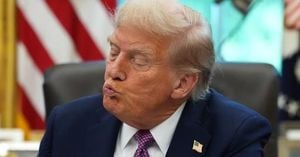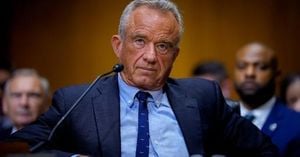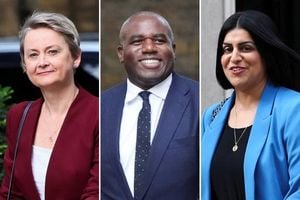Federal Reserve Chair Jerome Powell recently shared insights on the current state of the U.S. economy during an event hosted by the New York Times. His remarks indicate shifting perspectives on raising and lowering interest rates, as he emphasized the economy's resilience and the Federal Reserve's cautious approach to cutting rates moving forward. “The U.S. economy is in very good shape,” Powell stated, reinforcing the idea there’s little reason to anticipate immediate economic deterioration. He added, “The good news is we can afford to be a little more cautious.” This sentiment reflects Powell's belief in the economy’s upward momentum, inviting questions about the timing and necessity of interest rate adjustments.
The timing is particularly relevant as it approaches the Federal Reserve's upcoming policy meeting on December 17-18, the first of its kind since the pivotal Federal Open Market Committee (FOMC) meeting. Observers will closely watch how Powell's statements align with the broader consensus among policymakers, especially after mixed recent signals from the economy. For one, inflation has often shifted higher than expected, with recent data showing these rates impacting consumer spending and sentiment.
Supporting Powell’s view are notable statements from other Fed officials, creating the possibility of continued rate cuts through December. Senator Christopher Waller expressed during his address this week he was “leaning toward” reducing rates, underscoring the rate cut debate within Fed circles. This internal dialogue reflects not just differences of opinion, but the overall hesitance to accelerate decisions without sufficient evidence.
Currently, the labor market has tempered its earlier fears of decline, showing more stability than anticipated, allowing for greater flexibility from the Fed. Data revisions released recently suggested economic metrics might be more favorable than initially believed. Powell noted, “What happened instead was...the economy is even stronger than we thought.” This introduces optimism about the U.S. economic condition, putting pressure on the Federal Reserve to evaluate its decision-making framework around interest rates design.
Friday’s forthcoming labor market data will be particularly telling, as it aims to construct the broader picture affecting Federal Reserve policy going forward. Powell made it clear they will remain open when assessing incoming data before the next meeting, concerned about inflationary pressures continuing to weigh on the economy. Indeed, the inflation measure, the personal consumption expenditures price index (PCE), remains above the targeted 2%, which feeds uncertainty around the Federal Reserve’s next steps. The index, aside from food and energy costs, has fluctuated consistently, averaging 2.6% to 2.8% since May.
Challenging these forecasts is the broader economic climate, with the looming uncertainties surrounding potential policy shifts from the incoming Trump administration, particularly those addressing tariffs, which could stoke prices and impact financial stability. Federal Governors, like Richmond's Thomas Barkin, also hinted they would await more data before coloring their final decisions, reflecting this broader cautious sentiment.
The effects of the current economic state on common Americans are significant, especially for those just attempting to navigate their financial futures. Everything from student loans to rising consumer prices for goods and housing remains central as key areas of contention. The Fed's decisions are being made under these novel pressures where many Americans are yet posed to see improvements without simultaneous inflationary headwinds creating roadblocks.
Economists note, as consumer demand remains strong, bright spots emerge like increasing auto sales, indicating healthy spending behavior. Yet concerns still loom surrounding inflation control. Inflation rates marked their highest since April, compelling the Federal Reserve to avoid rash decisions which could, as some commentators suggest, lead to harmful economic ramifications.
Further speculation surrounds past policy measures, with critiques stating ultralow interest rates have fueled economic disparities. The strong opposition postulated by leaders such as John Michaelson reflects sentiments where rate cuts should, according to some experts, stay firmly off the table. He warned against reverting to ultralow rates which historically led to asset bubbles, emphasizing the need for moderation to safeguard against economical overheating.
The debate surrounding economic direction and Federal Reserve policies showcases the layered complexity at play. Powell and other Fed officials are striving to use recent economic news to calibrate their actions, straddling the line between vigilance and strategy as inflationary concerns stay elevated against unfamiliar economic landscapes.
With all eyes on the upcoming policy meeting and potential cost pressures shaping decisions on rate cuts, the questions surrounding the Fed’s cautious stance, legislative actions under new governance, and user demand trends remain pivotal. The Federal Reserve's ability to navigate these uncertainties will substantially influence not just the economy but also the everyday experiences of American citizens as 2024 looms.



